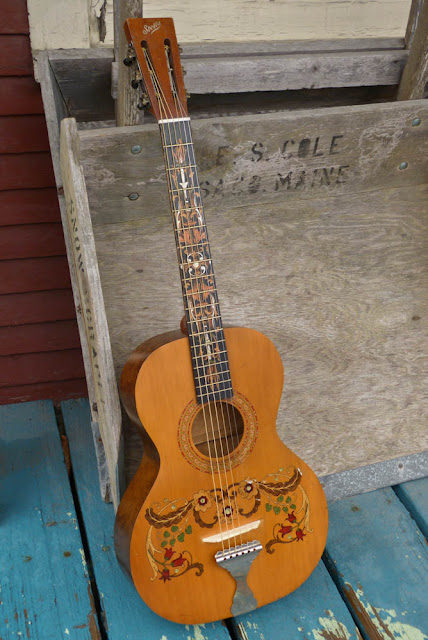1920s Oscar Schmidt "Stella" Decalcomania Tailpiece Guitar
This is #3 of a batch of 4 Oscar Schmidts I'm working on for a customer. This is almost the same instrument as from the last post, save that the quartersawn oak back and sides have been replaced with standard-issue birch and a suite of fancy decals have been placed on it to dress it up instead. It sounds comparable, too, though the bridge is slightly higher and coupled with the maple-ish-sounding birch that gives this a raucous, loud, and forward snap to the tone. For a fingerpicker this guitar projects almost as well as something like a 12-fret National single-cone. There's a reason country-blues players love these things!
The work was exactly the same as the last guitar, too: neck reset, fret level/dress (made slower by the decal-laden fretboard), some brace reglues, and a new bone bridge and saddle. I forgot to mention this in the last post, but I also tend to install a "popsicle" brace under the fretboard extension to give extra reinforcement in that area, too.
The work was exactly the same as the last guitar, too: neck reset, fret level/dress (made slower by the decal-laden fretboard), some brace reglues, and a new bone bridge and saddle. I forgot to mention this in the last post, but I also tend to install a "popsicle" brace under the fretboard extension to give extra reinforcement in that area, too.
It's hard to believe but this is 3 for 3 of old Oscars without cracks of any sort. This one has those luminous-backed decals that make these old fellas so attractive, too. See how there's a metallic/pearly gleam to the center of the flowers? It looks great in the sun.
This one has the Stella badging at the headstock rather than in the soundhole. It, too, has a 1 3/4" nut width and 24 7/8" scale that I've strung-up with 50w-11 strings. This one has a huge neck, though, and is a bit more trouble to get around on -- though the sound is worth the struggle.
It looks like it was also used as a Hawaiian guitar from the moment it left the factory as it has the wear-marks of a "nut extender" gizmo and the original wood nut wasn't worn-out like I'd expect it to be if it was being used regularly as a "Spanish" guitar.
The main attraction is this bizarre "tree of life" fretboard decal. I had to be careful when dressing the frets on this one so as not to damage the stuff.
I always like seeing this particular floral decal. It's like opening up the pages of an old illustrated childrens' book.
Here's my compensated mandolin-style bone bridge. These are almost always tonally superior to rosewood and ebony on these old tailpiece guitars to the extent that I rarely bother to make wood ones any more unless the effect is overly-bright.
One curious footnote: the vast majority of these tails were held on by nails when shipped from the factory. I always replace them with screws -- and try to use ones of a similar vintage.


















Comments